

xerimyco
-
Content count
19 -
Joined
-
Last visited
Posts posted by xerimyco
-
-
... i have done many times (in equador)...Cool! Did you live there? Still know people who could send cuts? Got any photos of the material?
... they can greatly reduce cooking times from say one hour to 15-20mins a cook say multiply times four and the extract can be done in an hour...If your pressure cooker is small enough to take to the sink and run water on it, and you are cool with carrying a cooker that's still pressurized, this is true. If not, it can take a lot longer. My big cooker takes more than 20 minutes to cool sufficiently to depressurize so I can open it. I hope everyone who thinks about using pressure cookers READS AND FOLLOWS THE MANUFACTURERS DIRECTIONS! They almost never blow up anymore, but the result of opening a pressurized cooker can be almost as bad. Superheated cactus mush volcano! Ballistic lids!
I know a lot of the fun of a hobby can be in the procedure, "it's the journey, not the destination", and that thinking about and devising elaborate techniques can be very good brain exercise. There is nothing wrong with putting a lot of effort into doing special projects like this. Do whatever turns you on. It's fun! When it comes down to it though, it is hard to improve on the product you get out of a simple chop and boil.
-
From one MS to the other I cannot fathom why anyone would puree any cactus when the constituents within the plant are fully water soluable. Regarding Trichocereus I can not find any account whatsoever in the traditional literature that it was consummed by any other means than a tea. Lophophora also has traditional usage as a tea even though this plant is also often eaten. From my observations of others' attempts to puree cactus the only thing it increases by any percentage is effort needed to process, this while not causing any great deal more alkaloids to be extracted, at least not more than can be gotten by using just a tad more plant material when making a tea. I've also come to think that consumming anything more than a slightly thickish tea increases nausea and stomach disconfort (cramps).~Michael~
Amen to that! Eating cactus puree is not fun (for most anyway), and will not get you where you want to go any better than tea. Just chop it up, boil and strain. De-spining, coring, peeling etc. just add work to the process. They don't hurt, but I don't think it makes any improvement over just chopping the whole stem. Blending is not only more work, but I think it actually messes things up. If you just cut it up, it is very easy to strain. Blended, you end up with the proverbial "elephant snot" mess that is a chore to strain and filter. It also seems to me that it doesn't get more of what you want out of the cactus (maybe less if you lose some trying to strain/filter it), but does get more of what you don't want.
Folks also tend to go overboard on the boiling. You don't need to boil for hours and hours, days, etc. Pressure cookers are a waste of effort too. Boiling for an hour, straining, and reboiling the pulp for another hour will get virtually all of what you want. Long boiling and pressure cooking don't hurt, but are wasted work in my opinion. Long boiling also increases the chance of boiling to dryness and burning, which will ruin your project. One thing that is slightly beneficial is adding a little acid to the boil water, especially if the water is high pH to begin with. Two grams of ascorbic acid (vitamin C) per gallon of water is enough. It is non-toxic, adds almost zero effort, and I believe it aids in the extraction in a small, but significant way. If you use too much though, you could get the runs (anybody whose taken over five grams of vitamin C are probalbly familiar with this effect).
My answers to your above questions:
1) No. Especially if you blow chunks trying to choke down the "shake".
2) Might actually be less than if you make tea.
3) Takes longer, might last longer too, though.
I vote tea, made simply.
-
Passive, you certain that is T. terscheckii? The flowers are a bit off. Can you give a better shot of the plant itself?Yeah, both the flowers and what you can see of the stem don't look like terschekii to me.
Here is a photo of what I've always called terschekii, in bloom, from earlier this year:
I really like whatever your plant is, though, and the nice photos you took of it. Thanks! I hope your crosses come out well.
-
II've given up on insect damage promoting cristation, and I think everyone may agree on that point.Snails are not insects.
Although I don't think insects are the main causative factor in the formation of crests or monstrose specimens, I do think that they are a factor. I think that in plants that are latently cristate or monstrose can be induced to express these traits by meristem stress caused by insect feeding. It seems that it is usually attacks by insects with sucking mouthparts that do this. Especially thrips. Since damage from insects that actually munch on the tissues don't seem to do this, I think it is a microorganism (probably a virus) of some type being vectored by the thrips that triggers the expression. I have seen this may times.
-
Thanks Torsten!
-
That looks like frost damage to me. And it is a Cleistocactus.
-
Torsten:
Do you use this as a sleep aid? As an anxiolytic? Something else?
Also, do you use it orally, or sublingually? I've read that it is not well absorbed/destroyed in the G.I. tract.
Anyone else's input is welcome also.
Thanks in advance!
xerimyco
-
Fantastic! You are obviously a very dedicated collector. You should be proud.
-
Looks more like Crassulaceae than Aizoaceae to me. Maybe a green Crassula capitella "Campfire".
It's active? How? Orally? What are the effects? How did your friend find out about it?
Very interesting.
I just went out and harvested a leaf of the crassula I mentioned above (from an almost dead plant), and to my surprise, it was somewhat bitter. Please tell us more about your friends experiences with this plant.
-
I'm very interested. I was going to order from Knize, but have hesitated because I've read that he isn't as reliable as he once was. Did you have any problems getting seed from him?
Anyway, since you already have them, I'd like to do some trading. I am in the U.S. also, so it will be easier to ship stuff to each other.
I will send a PM to you.
Thanks,
xerimyco
-
Conan, I think it T. chiloensis as well. T. chiloensis has somewhat variable growth habits, but this looks like your standard form.~Michael~
Thanks!
Sorry for the incorrect ID, Conan. I'm glad Michael corrected my error.
-
It's a tersheckii.
Trichocereus chiloensis.
Close-up of the meristem of the above plant.
A small tersheckii.
A couple very small (and not too nice) terscheckii.
Small tersheckii and small candicans look very similar, but as they get larger, tersheckii grows columnar and candicans creeps along the ground. Since you said the mother plant was a columnar (I can also see a columnar looking base in the photo), I'd bet tersheckii.Sorry I don't have a photo of candicans right now to post.
-
Hi GD, looks like Stenocereus. But the spines are very big for that size. bye EgI think you are right.
-
Trichocereus terscheckii(oid)?Yes.
-
Euphobia grandicornis, the Cow's Horn Euphorbia. And definitely look out for the latex! It is very nasty. Can put you in the hospital if you get it in your eyes.
-
Nice cactus!
It's a Pachycereus pringlei, or Cardon. It is native to the Baja peninsula of Mexico, and is considered by many to be the largest cactus. A fully mature plant is several times as big as this specimen.
-
Welcome xerimyco!small projects (a few hundred or thousand seeds)
larger projects (tens or hundreds of thousands)
Jeebers man!! Where do you source those sort of quantities?!?! Your idea of a small project certainly sounds like a huge one in my books - your large one would be enough to start a nursery!! lol
Where are you located? Arizona?
Thanks for the welcome Ace!
I was born into the nursery industry here in Arizona. I've grown and sold hundreds of thousands of cacti of numerous species, and I'm considered small fry here. I've worked with and am friends with folks that produce over a million plants (cacti) a year! When I find time (my most precious commodity), I will post a few pictures of some of the larger operations here in southern Arizona.
Thanks again for the welcome, I'm real happy to have found this forum. It is by far the most mature and infomative place I've found yet.
-
Hello greendreams!
As mentioned upthread, pasteurizing your soil is one of the best preventitives. Another very useful thing is and undiluted 3% H2O2 spray, this can be used before and after germination with excellent results.
As for airflow, in small projects (a few hundred or thousand seeds) a sealed container can work real well, especially if you pasteurized the soil and container toghether. For larger projects (tens or hundreds of thousands), sealed pasteurized containers are not practical- usually the seed flats are put in semi-permanent "tents" of clear sheet plastic to maintain humidity. In this case, as much air movement as possible is desired. I'm not sure why this works- I've always thought that maybe the spores and such can't germinate if they are flying around wildly on air currents instead of resting steady on the substrate.
I've never had a problem with algae. I don't see how it would hurt anything unless it actually physically covered up your seedling cactus.
GOOD LUCK!
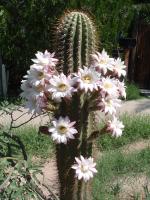
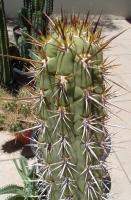
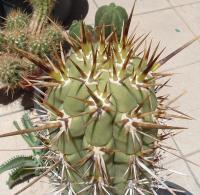
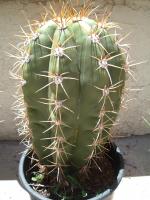
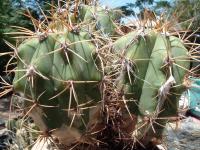
Drugs in be here now
in Ethnobotany
Posted
LOL! It's a dessert made with peaches and ice cream.
xerimyco